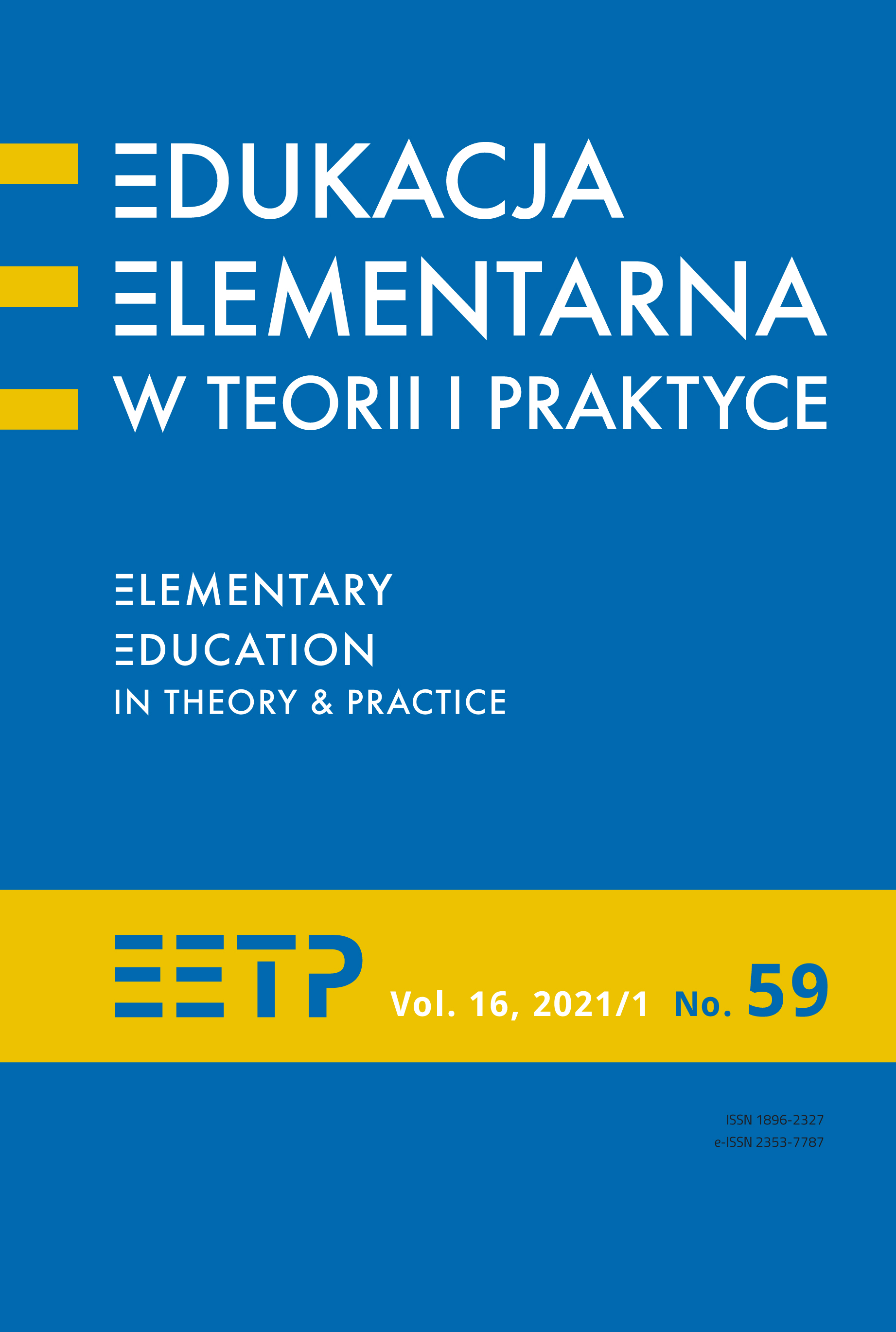Singing and Songs, and Education until Old Age in Early School Education
Abstract
The aim of the article is to draw our attention to the role and place of music education in the life and development of students in grades 1-3 of the primary school. The author describes the musical development of an early school child, she lists various functions of early music education, and she describes five forms of musical activity in which students should regularly participate. Due to the topic of this article, the author emphasizes that singing songs has many values connected with the overall development of pupils.
The next part of the article is a reflection on demographic changes and aging of the Polish society. Referring to the books on the subject, the author emphasizes that education until old age should be promoted in school education. She writes that teachers at school should stimulate correct and comprehensive development of pupils during classes, show the positive aspects of aging and old age, and shape proper attitudes towards seniors. This is possible, e. g. during music classes, with particular emphasis on singing and songs. The authors confirms it through the analysis of selected children's songs the lyrics of which are related to old age and seniors.
References
Bonna B. (2005). Rodzina i przedszkole w kształtowaniu umiejętności muzycznych dzieci. Zastosowanie koncepcji Edwina E. Gordona, Bydgoszcz: Wydawnictwo Uniwersytetu Kazimierza Wielkiego.
Danel-Bobrzyk D. (1999). Muzyka we wszechstronnym wychowaniu dziecka [w:] Muzyka w edukacji i wychowaniu, H. Danel-Bobrzyk (red.), Katowice: Wydawnictwo Uniwersytetu Śląskiego.
Dymon M. (2013). Wiedza i umiejętności warunkiem aktywności twórczej w edukacji muzycznej, Rzeszów: Wydawnictwo Uniwersytetu Rzeszowskiego.
Gloton R., Clero C. (1976). Twórcza aktywność dziecka, Warszawa: WSiP.
Główny Urząd Statystyczny, dane z 2019 r., www.stat.gov.pl [data dostępu 03.01.2020].
Januszewska-Warych M., Grabowksa G. (2002). Edukacja muzyczna w zintegrowanym systemie pracy w klasach 1–3 szkoły podstawowej. (Poradnik metodyczny), Słupsk, Wyd. Uczelniane PAP.
Kamper-Kubańska M. (2006). Wychowanie przez sztukę, czyli pedagogiczne, psychologiczne i terapeutyczne aspekty muzyki, [w:] Dylematy edukacji artystycznej. Edukacja artystyczna a potencjał twórczy człowieka, W. Limont, K. Nielek-Zawadzka (red.), Kraków: Oficyna Wydawnicza Impuls, s. 520-523.
Lipska E., Przychodzińska M. (1991). Muzyka w nauczaniu początkowym. Metodyka, Warszawa: WSiP.
Motyka W.( 2015). Muzykowanie w przedszkolu. teoria i metodyka, Rzeszów: Wydawnictwo Uniwersytetu Rzeszowskiego.
Rudnik A. (2016). Dzieci i młodzież wobec ludzi starych i starości – perspektywa pedagogiczna [w:] Obiektywny i subiektywny wymiar starości. Tom 2, Refleksje nad starością, E. Dubas, E. Muszyński (red.) , Łódź: Wydawnictwo Uniwersytetu Łódzkiego, s. 104-105.
Sacher W. A. (2012). Pedagogika muzyki. Teoretyczne podstawy powszechnego kształcenia muzycznego, Kraków: Oficyna Wydawnicza Impuls.
Stypińska J. (2010). Dyskryminacja osób starszych w Polsce. „Niebieska Linia”, nr 2.
Suświłło M. (2001). Psychopedagogiczne uwarunkowania wczesnej edukacji muzycznej, Olsztyn: Wydawnictwo Uniwersytetu Warmińsko-Mazurskiego.
Trzcionka-Wieczorek A. (2014). Edukacja do aktywnej starości w treściach podręczników szkolnych, [w:] Człowiek w przestrzeni lokalnej – dobre praktyki wspierania rozwoju, aktywizacji i integracji społecznej osób starszych, A. Szczurek-Boruta, B. Chojnacka-Synaszko (red.), Toruń: Wydawnictwo Adam Marszałek..
Trzcionka-Wieczorek A. ( 2017). Ćwiczenia śródlekcyjne przy muzyce jako ważny element w kształceniu zintegrowanym, „Nauczyciel i Szkoła” nr 4.
Watoła A. (2008). Muzyka w stymulowaniu rozwoju dziecka, „Wychowanie Muzyczne w Szkole” nr 2.
Zych A.A. (2012). Profilaktyka gerontologiczna a normalne i optymalne starzenie się, [w:] Poznać, zrozumieć i zaakceptować starość, A. A. Zych (red.), Łask: Wydawnictwo Over Group.
Copyright (c) 2021 Elementary Education in Theory and Practice

This work is licensed under a Creative Commons Attribution-NoDerivatives 4.0 International License.
- When submitting a text, the author declares that he/she is the Author of the article (hereinafter referred to as the “Work”) and:
- he/she owns the exclusive and unlimited copyright to the Work,
- is entitled to dispose of the copyright to the Work.
Declares that it does not infringe any third party copyrights or legal rights.
Declares that there is no conflict of interest.
2. At the same time, the Author grants the Ignatianum University in Cracowa royalty-free, non-exclusive and territorially unlimited licence to use the Work in the following fields of exploitation:
- recording the Work in a hard copy, as well as on a digital or magnetic medium;
- reproduction of the Work using any technique, without limitation of the number of editions or copies;
- distribution of the Work and its copies on any medium, including marketing, sale, lending, and rental;
- introduction of the Work into a computer memory;
- disseminating the Work in information networks, including in the Internet;
- public performance, exhibition, display, reproduction, broadcasting and re-broadcasting, as well as making the Work available to the public in such a way that everyone can have access to it at a time and place of their own choosing;
- within the scope of dependent rights to the Work, including in particular the right to make necessary changes to the Work resulting from editorial and methodical development, as well as to translate the Work into foreign languages;
The licence is granted from the moment of the transfer of the Work to the Ignatianum University in Cracow. The Ignatianum University in Cracow is entitled to grant further sub-licences to the Work within the scope of the right granted. The licence is time-limited and it is granted for a period of 15 years, starting from the date of its granting.
Authors are permitted and encouraged to publish their text online (e.g. in their institution’s repository or on the institution’s website) before or during the submission process as this may lead to beneficial exchanges, as well as earlier and greater citation of the published text (See The Effect of Open Access). We recommend using any of the following portals of research associations:
- ResearchGate
- SSRN
- Academia.edu
- Selected Works
- Academic Search




